Power amplifier on NE5532 - ty.ytka

It may seem ridiculous, but you can build an interesting power amplifier from ordinary operational amplifiers (with the right amount of them). :)
From this "miracle" I achieve 2×14 W on a load of 8 ohms. Maybe this value is not shocking, but considering what we get it from, it's probably not a little bit.
First things first.
This project was created only as an experiment, made out of curiosity.
The source of inspiration for this project was an article by Douglas Self in the Elektor magazine (issues 10 and 11 of 2010). Whereas the design of my headphone amplifier ( link ) served as a fitting for this very crazy project.
However, my project is not an exact copy of the mentioned article. I simplified it a bit in my experiment. I resigned from balanced inputs and the possibility of connecting both channels into a bridge. I made the security system on uPC1237, and the stabilizers on LM338.
I assembled the whole amplifier on three boards. One containing stabilized power supplies, supplying +/-18 V, and a loudspeaker protection system. The other two contain amplifiers for each channel. Each channel contains 4 operational amplifiers in the voltage amplifier part, 64 operational amplifiers connected in parallel working as an output buffer and one op-amp operating in the DC-servo system.
Tile schemes:
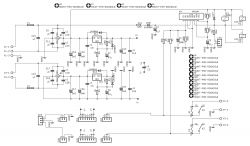

A few photos of the assembled layout:

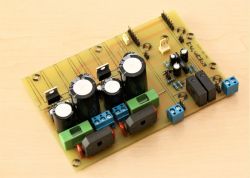
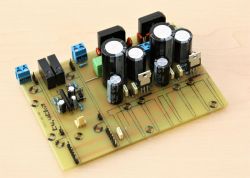
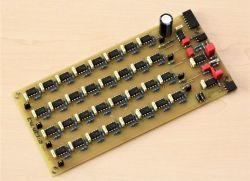




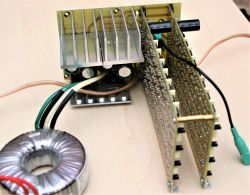
Now maybe a few words about the impressions of the final effects.
Overall, I perceive the amplifier very positively from the listening point of view. The presented sound is quite detailed, clean without coloration. I was surprised by the quality of the bass, but in my opinion it is due to the quality of the power supply (stabilizers).
For now, I do not plan to use this project for a specific purpose, but I also do not rule it out in the future. However, it is quite interesting in terms of sound.
However, if someone wanted to use something like this for a specific purpose, remember to ensure proper cooling. Unfortunately, the stabilizers have to dissipate quite a lot of heat, and even the operational amplifiers themselves heat up to about 45-50 degrees Celsius during such operation.
Something about parameters.
Output power with simultaneous control of both channels - 2×14W on 8 ohms .
Other parameters are presented in the table below. Values for three different output powers 1W, 10W and 14W .

The author of the article mentioned at the beginning achieved slightly different parameters in his experiment:
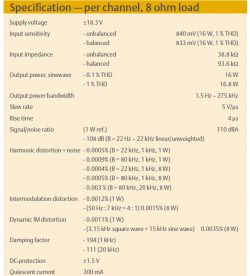
The differences in the obtained parameters could have been influenced by the simplification of my system and the fact that I used the cheapest version of NE5532, because " P ".



Comments
I read that article some time ago (although not in Elektor) and I was very interested in it. So much so that I also decided to implement this seemingly crazy project someday. Unfortunately, the word "someday"... [Read more]
The concept seems older than 2010 to me. Your performance is very nice. I also like that you managed on a single-sided PCB. Such a curiosity. Recently, on Aliexpress, I also came across several such... [Read more]
Overall nice but for the fan and for fun. What did you measure with? Do you have a card reference measurement? Because you don't know where the measurement limits are. The second thing, do you have... [Read more]
I also found similar modules on Aliexpress. Only they break everything into mini-blocks. Those boards that colleague rb401 pointed out are the output buffers themselves. They even offer such little things: ... [Read more]
AVE... This is a very well made design, and an interesting concept, although usually parallel connection of operational amplifiers is practiced in order to reduce noise in ultra-sensitive measuring amplifiers.... [Read more]
Considering that for 5 USD we can buy 100 pieces of NE5532 in SMD, the project makes quite a lot of sense. [Read more]
AVE... The only question is, are these cheap NE5532 originals or Chinese clones? If they are clones, do they therefore keep their parameters? [Read more]
Very interesting design, that's what DIY is for! Write to me in a parcel locker and I will be happy to send you a gift. [Read more]
Here is the promised reference measurement of the card used for the measurements: https://obrazki.elektroda.pl/2831165000_1688501807_thumb.jpg And as for the price with the NE5532 used. As I mentioned,... [Read more]
This is real DIY, in an exemplary execution; that's what the DIY department is for. Now we are waiting for posts that will expose "non-compliance of the device made with the standards", buddy @tytka... [Read more]
Who was calling me? ;) I really like this experiment. Generally, connecting several amplifiers in parallel eliminates noise, but ... without exaggeration ;P Maybe it's worth using amplifiers in SOT23-5... [Read more]
Can you reveal what you modified in UMC202HD to get such good parameters? [Read more]
I strongly warn against using these cubes and others from the LM321, 358, 324 group in this construction. It's just that in these amplifiers, in applications where the output current changes direction,... [Read more]
@lechoo I limited the input path of this card to a minimum, because as it turns out, the factory Midas input amplifiers are a total flop and the reason for the imperfection of this card. I described my... [Read more]
Will your colleague reveal details about this security? Input diodes? Because this Behringer really hums badly and I'm getting ready to etch the board to use the workaround described by a colleague... [Read more]
It is conceptually similar to this project: Headphone amplifier based on NE5532 Quite a neat design (both the author's and Phil's from the movie) [Read more]
Thanks for the information, I didn't know about that. I'm thinking... Let's give 4 sets of amplifiers powered from +-22V, let's connect them into 2 separate bridges. This would give 44Vpeak,... [Read more]
This cube is basically the same as the LM358 and has the same characteristic of these specific distortions as this whole family. So it is definitely not suitable for this construction. [Read more]
This generally looks like a feature of BJT-based amplifiers. Versions based on JFET transistors do not have such problems. [Read more]